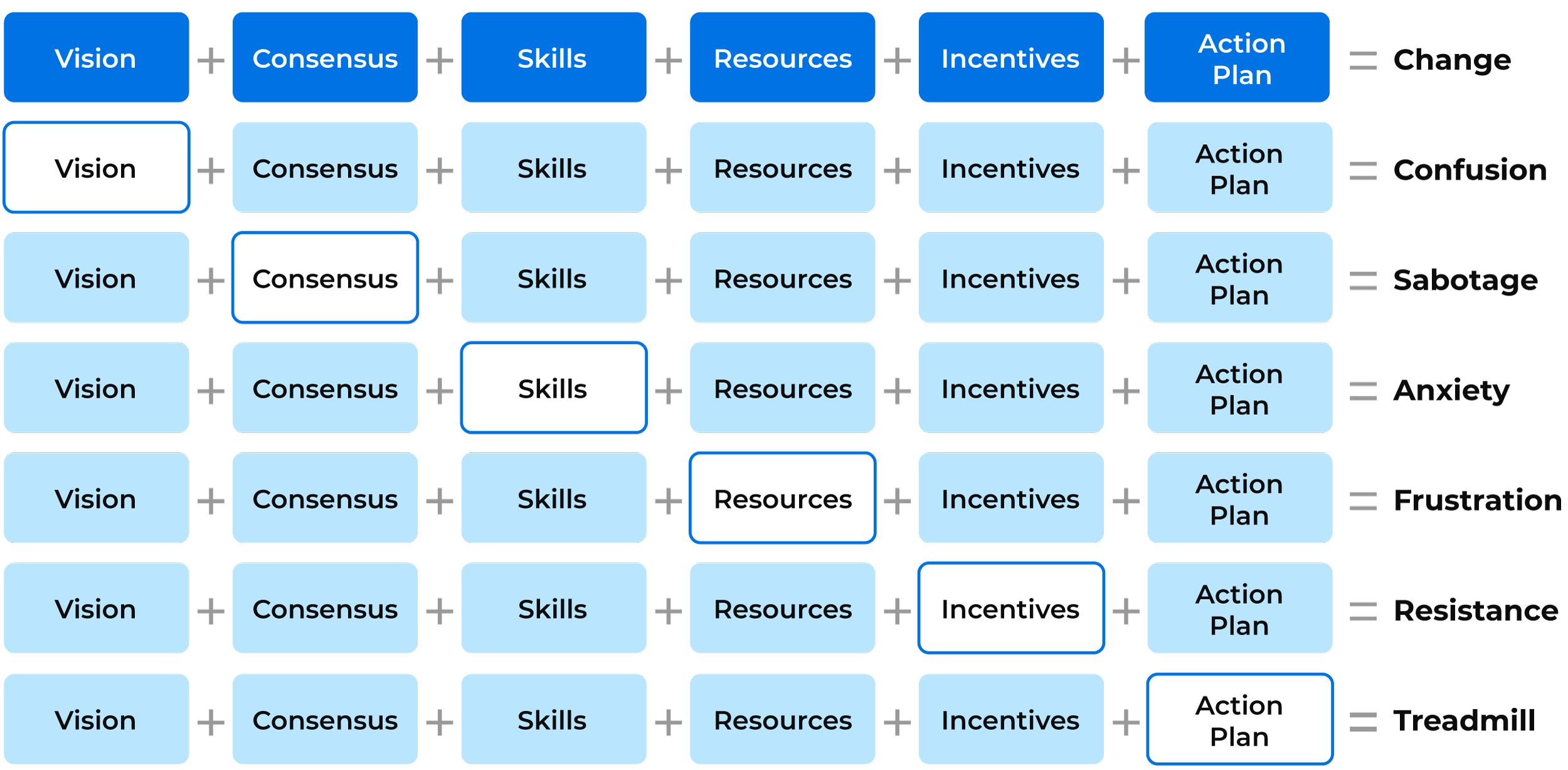Rolling out a process management tool can provide transformative benefits to an organization, but only if there is a culture of process improvement in place. We know this firsthand, having been responsible for the rollout and administration of an enterprise process improvement initiative using Nintex Process Manager as the primary business process management system.
It’s a complex task that requires effective organizational change management, and a potentially daunting one, especially if you’re not on the leadership team.
However, it is possible to lead organizational change efforts when you’re not in charge. One framework to consider for managing this change is the Lippitt-Knoster model, which highlights six key elements required for effective change: vision, consensus, skills, resources, incentives, and an action plan. Without any one of these elements, your change effort is likely to fail.
You will also need to involve and gain support from all levels of the organization, including leadership, middle management, and individual contributors. A bottom-up, grassroots approach is not enough on its own, so it is important to focus on gaining leadership support. In this blog, we’ll focus on gaining leadership support for your initiative by planning around the six elements of the Lippitt-Knoster model.
Vision
The key to building a successful, enterprise-wide process improvement initiative is defining a clear vision for how it will benefit the organization. To do this, conduct a listening tour to gather feedback and insights from stakeholders across the company, including leadership. This will help identify the organization’s key issues and concerns (for example, tribal knowledge and silos).
Next, spend time crafting a vision for how a process improvement initiative can address these issues and improve the company’s overall performance. The vision should clearly state the problems the company is facing (why the change is needed) and how the initiative can address those problems and mitigate future risks.
Once you have developed a vision that resonates with key stakeholders, take it to your leadership team for approval to plan the rest of your campaign around it. By involving leadership and securing their help, you can build a thriving culture of process improvement throughout the organization.
Consensus
When implementing a process improvement initiative, be prepared for the possibility that not everyone will be on board with the proposed changes. Change is difficult, and previous change management efforts may have negatively impacted some teams. In these cases, take the time to understand their concerns and address them directly. Consensus building is a crucial part of implementing a process improvement initiative and can take significant time and ongoing effort.
When you experience pushback, be clear that process improvement is not a panacea, and there will be business problems that can’t be solved through these efforts alone. Strive for agreement on the problems that process improvement can address from the majority, if not all, of leadership to avoid sabotage—intentional or unintentional—of the planned culture change.
Even after initial consensus is reached, you will need to continue working to build support and maintain momentum. Teams may get distracted by everyday work challenges and revert to old habits if the behavioral changes promoted by the initiative are not continually reinforced. It is important to engage with leaders regularly to ensure the organization stays committed to improving processes.
Skills
Provide targeted training for leadership on the critical concepts and tools of process management to ensure leaders have the necessary skills to lead the change effectively. This training should be tailored to the specific needs and level of knowledge of the leadership team. It should include general concepts and specific tools and systems used in the initiative.
For example, the training may include process improvement concepts such as process ownership, documentation, and metrics as well as hands-on training in specific tools such as Nintex Process Manager. By providing leadership with the appropriate training and skills, you can help alleviate anxiety and ensure they feel confident deploying the toolset with their teams.
Resources
A lack of resources in an organization will always lead to frustration. For a large-scale change effort like building a process improvement culture, frustration can kill your efforts quickly. To avoid frustration when implementing a process improvement initiative, secure the necessary resources like budget, staff, and time early on—preferably while you build your vision statement.
Crucially, tailor your process improvement initiative to fit the resources available to you, as well. Don’t plan to create a large, centralized process improvement team if you don’t have the resources to support it—a decentralized approach with elected process champions from each department would be a better approach in this scenario.
In addition to securing a budget for a suitable toolset like Nintex Process Manager, it’s essential to advise leadership that time is the most crucial resource in this initiative. Process improvement may require a temporary decrease in productivity to yield an exponential increase later. Ask them to support and encourage their teams to prioritize process improvement activities accordingly.
Incentives
You will need more than just leadership agreement that process improvement is integral to the organization’s culture. They also need to agree to act and potentially change some of their management behaviors to incentivize employees for positive process management efforts. Leverage the leadership team to make process improvement a shared responsibility and part of the organization’s regular business operation through objectives and key results (OKRs), key performance indicators (KPIs), or business goals and objectives (BGOs). Ensure that leadership understands they must make process improvement conversations a part of regular company briefings.
In addition, work with leadership to shift the narrative around the behaviors the company values. Instead of rewarding employees for firefighting, focus on rewarding sustained process management behaviors. When leadership focuses on rewarding and recognizing firefighters, they tend to recognize the same individuals closest to the same critical processes over and over. This can disincentivize other employees, lower morale, and staunch any broader process improvement suggestions due to a perceived lack of leadership interest.
A better approach is to reward good process management and improvement efforts across the organization. This benefits the entire culture. It encourages all employees to prioritize processes and makes recognition possible for everyone in the organization, rather than just those consistently dealing with urgent issues due to broken critical processes.
Action plan
Launching your initiative without an action plan—or with only a vague outline of an action plan—will land you on a treadmill of slow, painful progress and false starts that will lead to an eventual loss of confidence in your initiative.
Once you have obtained leadership approval, built consensus, trained leadership, secured resources, and discussed the required managerial behaviors, develop a detailed action plan for implementing the process improvement initiative across the organization. The action plan should be tailored to each team’s needs, and all stakeholders’ input should be sought. Don’t force a one-size-fits-all approach to the rollout if it does not make sense. For example, avoid asking the finance team to work on their process improvements near the end of the fiscal year when they are heavily burdened with other obligations. Your action plan should include precise requirements and scope for each team and be documented in accordance with your organization’s project planning methods and norms.
To ensure the initiative’s long-term success, include succession planning for executive champions. Turnover at the leadership level can derail a process improvement initiative, so plan for contingencies to ensure the process improvement culture remains in place even if there are leadership changes.
Organizational change is never easy; it is a long-term endeavor, not a short-term effort. Taking the time to carefully plan your organization’s process improvement initiative around these six elements will help you avoid a variety of missteps.

In the next blog in this series, we’ll discuss how to apply this framework to middle management and individual contributors at your organization.
For additional reading, see the following blogs:
- Leadership can create a halo effect for improvement cultures
- Leadership traits that stop innovation in its tracks
- How to get leadership buy-in for process mapping tools
- How to start a process center of excellence
- How to create a process culture that works
- Attention C-suite: Process management matters – especially to your frontline employees
- Why your organization needs a process center of excellence
Or watch the Nintex Process Manager demo on-demand
